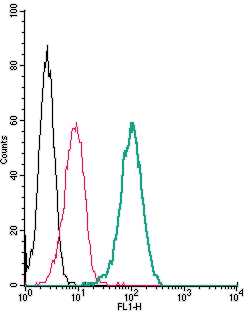Overview
- Peptide (C)NSGKELSLHWRPKD, corresponding to amino acid residues 16-29 of mouse LPA2 receptor (Accession Q9JL06). Extracellular, N-terminus.

 Western blot analysis of rat colon (lanes 1 and 3) and human colorectal adenocarcinoma (colo205) (lanes 2 and 4) lysates:1,2. Anti-LPAR2 (EDG4) (extracellular) Antibody (#ALR-032), (1:200).
Western blot analysis of rat colon (lanes 1 and 3) and human colorectal adenocarcinoma (colo205) (lanes 2 and 4) lysates:1,2. Anti-LPAR2 (EDG4) (extracellular) Antibody (#ALR-032), (1:200).
3,4. Anti-LPAR2 (EDG4) (extracellular) Antibody, preincubated with LPAR2/EDG4 (extracellular) Blocking Peptide (#BLP-LR032).
- Yun, C.C. et al. (2005) Am. J. Physiol. 289, C2.
- Feng, Y. et al. (2014) Exp. Ther. Med. 7, 423.
- Knowlden, S. et al. (2013) Atlas of Genetics and Cytogenetics in Oncology and Haematology 17, 259.
- Contos, J.J. et al. (2002) Mol. Cell. Biol. 22, 6921.
- Fang, X. et al. (2000) Ann. N.Y. Acad. Sci. 905, 188.
Lysophosphatidic acid (LPA) is a lipid mediator that induces various cellular responses including proliferation, migration and inhibition of apoptosis in numerous types of cells via its specific G protein-coupled receptors. At least 5 LPA G-protein coupled receptors (GPCRs) have been identified so far. LPA mediates its effects predominantly by interacting with members of the endothelial differentiation gene (EDG) subfamily of GPCRs: LPA1/EDG2, LPA2/EDG4, and LPA3/EDG71. LPA2 couples to three distinct families of heterotrimeric GTP binding proteins, including Gαq, Gαi, and Gα12/132.
LPA2 spans the plasma membrane seven times and contains three extracellular loops and three intracellular loops. LPA2 is unique from the other LPA receptors as it contains two distinct protein-protein interaction domains in the carboxyl-terminal tail (aa 296-351). In the proximal region, LPA2 contains a di-leucine motif and several putative palmitoylated cysteine residues. This region is responsible for associating with zinc-finger proteins3.
LPA2 mRNA is expressed in a variety of tissues including human testis, leukocytes, prostate, spleen, thymus, pancreas, and bone marrow3.
LPA2-null mice do not show any obvious phenotypic aberrations5. On the other hand, LPA2 expression is increased in ovarian and thyroid cancers and inflammation, suggesting that the main function of LPA2 could become evident under pathophysiological conditions6.
Application key:
Species reactivity key:
Anti-LPAR2 (EDG4) (extracellular) Antibody (#ALR-032) is a highly specific antibody directed against an epitope of the mouse LPA2 receptor. The antibody can be used in western blot analysis. It recognizes an extracellular epitope and thus is ideal for detecting the receptor in living cells. It has been designed to recognize LPA2 receptor from human, rat, and mouse samples.
Applications
Citations
- Human dermal fibroblasts cell lysate (1:1000).
Olianas, M.C. et al. (2020) Eur. J. Pharmacol. 873, 172963. - Rat C6 glioma cell lysate.
Olianas, M.C. et al. (2016) J. Pharmacol. Exp. Ther. 359, 340.

